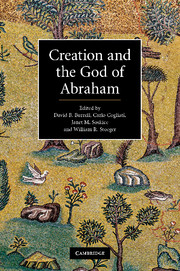Book contents
- Frontmatter
- Contents
- Contributors
- Preface
- Introduction
- 1 Creation ex nihilo: early history
- 2 Creatio ex nihilo: its Jewish and Christian foundations
- 3 The act of creation with its theological consequences
- 4 Scotistic metaphysics and creation ex nihilo
- 5 Creation and the context of theology and science in Maimonides and Crescas
- 6 Creation: Avicenna's metaphysical account
- 7 Four conceptions of creatio ex nihilo and the compatibility questions
- 8 Will, necessity and creation as monistic theophany in the Islamic philosophical tradition
- 9 Trinity, motion and creation ex nihilo
- 10 The Big Bang, quantum cosmology and creatio ex nihilo
- 11 What is written into creation?
- 12 Creatio ex nihilo and dual causality
- 13 God and creatures acting: the idea of double agency
- 14 Thomas Aquinas on knowing and coming to know: the beatific vision and learning from contingency
- Index
- References
7 - Four conceptions of creatio ex nihilo and the compatibility questions
Published online by Cambridge University Press: 07 September 2010
- Frontmatter
- Contents
- Contributors
- Preface
- Introduction
- 1 Creation ex nihilo: early history
- 2 Creatio ex nihilo: its Jewish and Christian foundations
- 3 The act of creation with its theological consequences
- 4 Scotistic metaphysics and creation ex nihilo
- 5 Creation and the context of theology and science in Maimonides and Crescas
- 6 Creation: Avicenna's metaphysical account
- 7 Four conceptions of creatio ex nihilo and the compatibility questions
- 8 Will, necessity and creation as monistic theophany in the Islamic philosophical tradition
- 9 Trinity, motion and creation ex nihilo
- 10 The Big Bang, quantum cosmology and creatio ex nihilo
- 11 What is written into creation?
- 12 Creatio ex nihilo and dual causality
- 13 God and creatures acting: the idea of double agency
- 14 Thomas Aquinas on knowing and coming to know: the beatific vision and learning from contingency
- Index
- References
Summary
INTRODUCTION
The notion of creatio ex nihilo has become a doctrine firmly established in the three Abrahamic religions (i.e., Christianity, Judaism and Islam). Almost all groups of Islamic thinkers accept the truth of the createdness (creatio) of the universe, and that it is preceded by its “non-existence” (ex nihilo). However, there is a diversity of opinions as to whether the concept of creatio ex nihilo is compatible with alternative accounts of the origin of the physical world, and this diversity is particularly marked between Islamic philosophers and kalam theologians (Mutakallimun). Three major factors, independently or together, play a fundamental role on how Islamic scholars deal with this very issue: (a) their views of the physical world; (b) their approaches to the divine attributes; and (c) their understandings of the teachings of their religion. The aim of this chapter is to investigate whether four different notions of creatio ex nihilo espoused by different Islamic thinkers are compatible with seven alternative accounts of the origins of the universe (five philosophical/theological doctrines – first level of compatibility; and two possible interpretations of a modern scientific theory – second level of compatibility).
FOUR CONCEPTIONS OF CREATIO EX NIHILO AND THE FIRST LEVEL OF COMPATIBILITY QUESTIONS
To provide an appropriate setting for the debate about creatio ex nihilo (hereafter CEN) and to prevent any confusion it might be useful to classify some of the most important Islamic views on CEN into four conceptions: (a) temporal-historical (TH); (b) essential non-temporal (ENT); (c) objective meta-temporal (OMT); and (d) substantive temporal non-historical (STNH).
- Type
- Chapter
- Information
- Creation and the God of Abraham , pp. 91 - 106Publisher: Cambridge University PressPrint publication year: 2010



